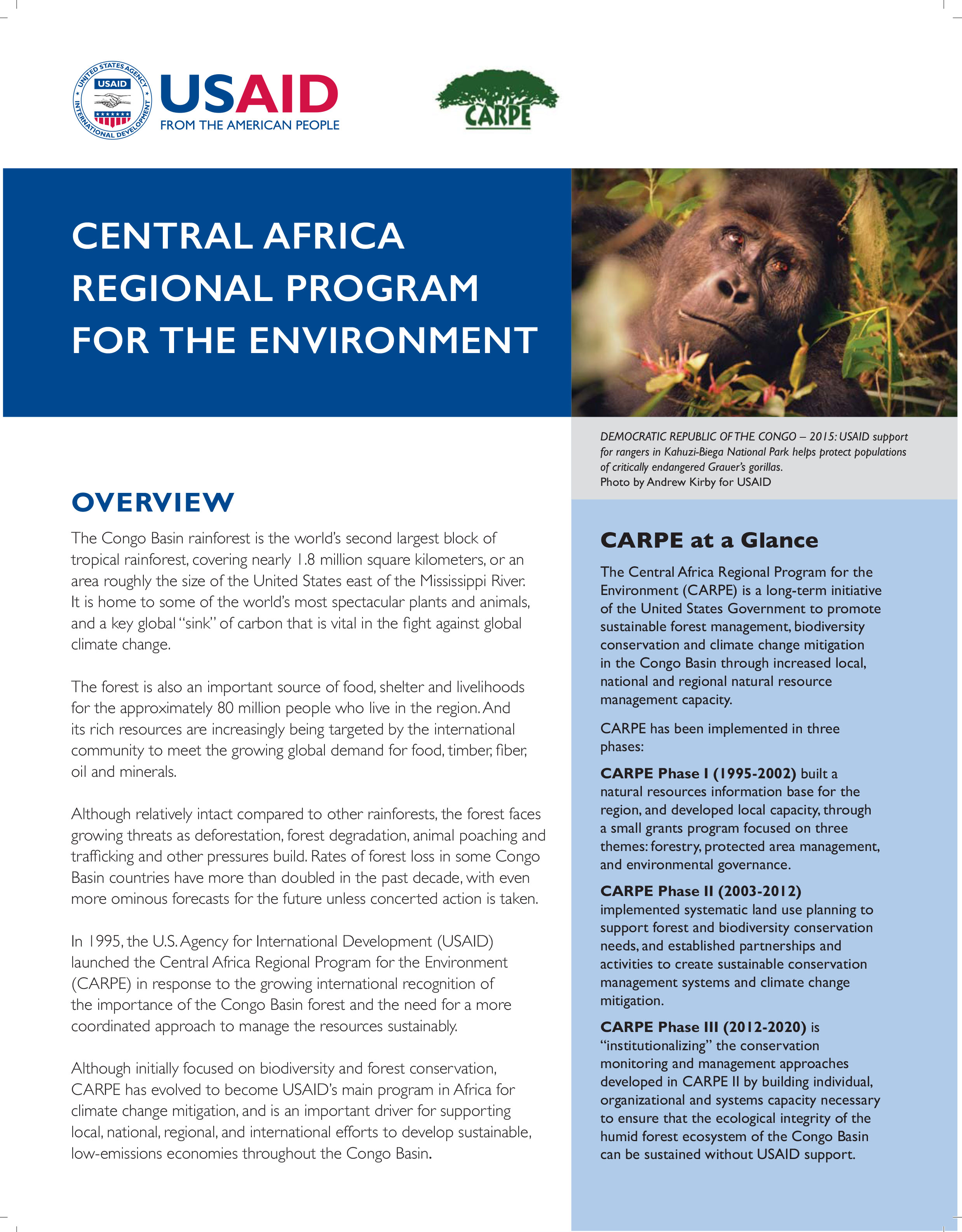CENTRAL AFRICA REGIONAL PROGRAM FOR THE ENVIRONMENT ![]() (pdf - 4 MB)
(pdf - 4 MB)
Overview
The Congo Basin rainforest is the world’s second largest block of tropical rainforest, covering nearly 1.8 million square kilometers, or an area roughly the size of the United States east of the Mississippi River. It is home to some of the world’s most spectacular plants and animals, and a key global “sink” of carbon that is vital in the fight against global climate change.
The forest is also an important source of food, shelter and livelihoods for the approximately 80 million people who live in the region. And its rich resources are increasingly being targeted by the international community to meet the growing global demand for food, timber, fiber, oil and minerals.
Although relatively intact compared to other rainforests, the forest faces growing threats as deforestation, forest degradation, animal poaching and trafficking and other pressures build. Rates of forest loss in some Congo Basin countries have more than doubled in the past decade, with even more ominous forecasts for the future unless concerted action is taken.
In 1995, the U.S. Agency for International Development (USAID) launched the Central Africa Regional Program for the Environment (CARPE) in response to the growing international recognition of the importance of the Congo Basin forest and the need for a more coordinated approach to manage the resources sustainably.
Although initially focused on biodiversity and forest conservation, CARPE has evolved to become USAID’s main program in Africa for climate change mitigation, and is an important driver for supporting local, national, regional, and international efforts to develop sustainable, low-emissions economies throughout the Congo Basin.
Programs
USAID’s primary objective is to maintain the ecological integrity of the humid forest ecosystem of the Congo Basin through sustainable land management.
To help achieve this, the CARPE program uses a participatory approach that is both top-down and bottom-up. It works at the local level with forest-dwelling communities and at the national level with an array of government departments, regional bodies, international organizations, and the private sector.
USAID’s partners include federal agencies, such as the Department of Interior (U.S. Fish and Wildlife Service, National Park Service, U.S. Geological Survey), the U.S. Department of Agriculture (U.S. Forest Service and the Foreign Agricultural Service), the National Aeronautics and Space Administration (NASA), the Department of State, and the Department of Justice.
Partners also comprise an array of national, regional, and international organizations, including the African Wildlife Foundation, Wildlife Conservation Society, World Resources Institute, World Wildlife Fund, the University of Maryland, the Central Africa Forest Satellite Observatory1 and the Council for the Defense of the Environment through Legality and Traceability.
USAID works with these partners to conserve key landscape environments, and mitigate forest and biodiversity loss and forest degradation threats, by contributing to the development and implementation of sound environmental policies and regulations, and strengthening capacities to monitor forest cover change and greenhouse gas emissions.
USAID is implementing two new, interdependent projects in the third phase of CARPE, “institutionalizing” the management of the Congo Basin forest through individual, organizational, and systems capacity building:
The Central Africa Forest Ecosystems Conservation (CAFEC) project focuses on developing sustainable forest management approaches, wildlife conservation and climate change mitigation activities in eight diverse natural forest landscapes.
The Environmental Monitoring and Policy Support (EMAPS) project focuses on improving national and regional environmental policies and regulations, building the capacity of public and private institutions for forest and biodiversity conservation, and boosting the quality and scope of conservation management, climate change mitigation and forest monitoring.
USAID’s success with CARPE has helped spawn several pilot projects to reduce emissions from deforestation using a climate change mitigation policy framework. These projects have attracted investment from bilateral donors, including Norway, Sweden, Belgium, Germany, the Netherlands and the United Kingdom; from multilateral donor funds at the World Bank and the African Development Bank; and from private organizations, such as Wildlife Works. In 2013, USAID and the Government of Norway entered into a significant partnership, coordinating efforts and combining the strengths of two of the largest forest conservation donors.
USAID’s experience with global climate change activities provides CARPE with the technical and training expertise to develop initiatives designed to reduce greenhouse gas emissions, increase carbon sequestration and improve forest management. This includes capacity building to capture and analyze data on forest cover and forest cover change, developing methodologies for forest inventory and carbon stock assessment and guidance for local, participatory land use planning and management of protected areas. These are all key elements for creating sustainable systems for improving forest conservation and mitigating climate change.
USAID’s anti-trafficking experience enhances CARPE’s work with local communities to strengthen detection, apprehension, reporting and prosecution of poaching and other trafficking activity, and to boost economic incentives for local communities to protect the wildlife in their area. Projects focus on protecting wildlife and forests in hot spots in targeted landscapes within the CARPE program area, such as national parks and wildlife reserves. USAID, through its implementing partners, develops and deploys effective technologies and analytic approaches, such as the Spatial Monitoring and Reporting Tool (SMART) to combat these threats. Using SMART, eco-guards and rangers are able to collect real-time data on wildlife in the landscapes, thereby increasing patrol effectiveness by concentrating on high-intensity poaching zones within the protected areas, facilitating apprehension of poachers at entry and exit points and arresting and turning the criminals over for prosecution.
USAID partners with key regional organizations, such as the Congo Basin Forest Partnership (CBFP), which promotes the sustainable management of the Congo Basin’s forests and wildlife by improving communication, cooperation and collaboration; and with regional bodies, including the Central African Forests Commission (COMIFAC), to coordinate common approaches to avoid trans-border “migration” of the drivers of deforestation, forest degradation and biodiversity loss due to differences in national policies and technical implementation capabilities.








Comment
Make a general inquiry or suggest an improvement.